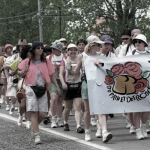In the early days of colonial settlement into “the Canadas”, some of the largest construction projects were the building of canals to secure safe routes for the movement of people and the trade of goods. The 1820s saw major undertakings across the Great Lakes and St. Lawrence River regions including the Lachine Canal at Montréal, the Welland Canal to connect Lakes Erie and Ontario, and the Rideau Canal to connect Montreal with Kingston by way of the Ottawa, Rideau and Cataraqui Rivers.
Work in canal construction was hard and done by hand using small tools, picks and shovels. There was little use of animals, so the rocks and soil the workers dug was hauled away by wheelbarrow. A canal “Navvie”, short term for navigator, worked 14 to 16 hour days, 6 days a week.
Working conditions were often deplorable. During construction of the Rideau Canal, around 1000 workers lost their lives to worksite injuries or disease. Some died during the blasting of rock, others drowned in rivers or swamps, but most died from diseases like “Ague” or “swamp fever”, a form of malaria carried by mosquitos. Today, the canal is dotted with monuments and memorials to the men and women who toiled and died along its length.
Workers were also vulnerable to exploitation. The money earned by workers was vulnerable as the men who hired them also acted as sellers of food, shelter, whiskey and tobacco – an early “company store”. In winter, there was often little other work available to support a family. Often, workers found themselves pitted against one another in a struggle for limited work – protestant workers vs catholic workers, French-speaking workers vs English-speaking workers – all to the advantage of employers.
However, some of the early struggles at Bytown managed to unite all workers. The March 2, 1829 riot was not the first time workers had risen up to protest poor pay and working conditions. Work on the Rideau Canal stopped three times in 1827 because of worker protests.
Throughout history, workers have found power when they came together and worked for the common good. In 1167 BC, there is recorded history of organized work-action during the building of the pyramids in Egypt. Angry about poor treatment and food rations, workers downed their tools until the Pharaoh conceded to their demands. Craft guilds formed in medieval Europe as a means for skilled workers to control the quality of their craft and the value of their labour. The trade and industrial unions of the 19th and 20th centuries transformed society, taking the working-class out of the world written about by Dickens and into the prosperity of the middle class.
Today, where workers have rights to unions, collective bargaining and to legally strike, it is rare for them to riot over working conditions. However, working people do still take to the streets when it is time to demand fairness – often with the help of the labour movement and union members. The “fight for 15 and fairness” and public campaigns to expand public pensions, pharmacare, and ban asbestos are recent examples of how unions help working people make a difference.


